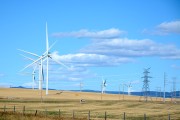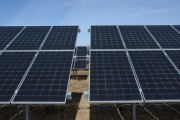The cap of 900 megawatts of wind power imposed by the Alberta Electric System Operator (AESO) makes Alberta the only province to cap one of the fastest growing energy industries in the world and forfeits the province's lead in developing this renewable resource.
Alberta is endowed with a vast supply of energy that includes not only non-renewable fossil fuels, but also a world-class wind resource. Alberta has 284 megawatts of installed wind energy capacity, more than any province in Canada. But this Alberta advantage is about to be eclipsed - possibly for good. Instead of promoting Alberta's leadership in wind power, a recently announced arbitrary cap on wind power projects threatens to pull the plug on billions of dollars of investment in the province.
Meanwhile, hot on Alberta's tail is the province of Quebec. The province has an installed capacity of 212 megawatts, a commitment to an additional 1,244 megawatts and Quebec is currently in the process of tendering development for a further 3,500 megawatts of wind energy.
When completed, Quebec will have more wind power than the rest of the country combined; enough to power more than to 1 million Canadian homes every year. In taking the lead in harvesting this renewable low-impact technology, Quebec has also understood the economic spin-off potential of the wind industry.
Wind energy is the fastest growing energy source in the world, with well over a decade of growth rates exceeding 30% that make its growth comparable to the pace of the high-tech boom. Much of this development has occurred in Europe in countries such as Denmark, Germany, Spain and the United Kingdom. As a result, it is not surprising that European technology and manufacturers also dominate the industry. In fact, most of the 1,000 megawatts of equipment that operates in Canada today has been imported from Europe.
With oil prices on the rise and the continuous improvement of wind technology, it does not take much foresight to realize that wind will provide a significant portion of North America's future energy supply. By creating a large market with long term stability, Quebec has also created a hot market for wind energy manufacturers to set up shop locally. In the long term Quebec manufacturers will no doubt contribute to North America's hunger for local energy supplies.
There is room for more wind energy manufacturing in North America, and no other province is in better position to not only take advantage of its own natural resource, but to use some of the revenue from its non-renewable energy resources to create a sustainable energy supply than Alberta. Yet, instead of creating or even allowing for a long-term industry in the province, Alberta is doing the opposite. Despite having a first class wind resource, an early national lead in developing wind farms and demand for power, the Government of Alberta has not only failed to foster the industry but has in fact stymied its growth.
The province has been very slow in upgrading the transmission lines required to pump wind energy from southern Alberta to areas of demand, effectively grinding investment in the province to a halt and stranding billions of development dollars. Furthermore, the Alberta Electric System Operator's arbitrary and indefinite cap of 900 megawatts of wind power caps the industry at a level less than one-third of what Quebec has already committed to installing.
While the AESO has reason to be careful about integrating wind into the Alberta grid, a hard cap is a blunt instrument that sends a pointed economic signal to developers and investors. Meanwhile, Denmark is already generating over 20% of its domestic power from the wind and is aiming for 50% by the year 2025. The self-imposed AESO cap in Alberta is well below what Denmark has already proven is possible, let alone the target they are aiming for.
Wind power will be an important part of the electricity supply for North America. Our choice in Alberta is to continue to be on that leading edge in the country or fall back and watch billions of dollars of investment channel into Quebec and Ontario. While Ralph Klein has admitted that he had no plans to capitalize on the oil boom, it is about time Alberta demonstrated foresight and used our non-renewable windfall to lead us to an environmentally and economically sustainable future.





